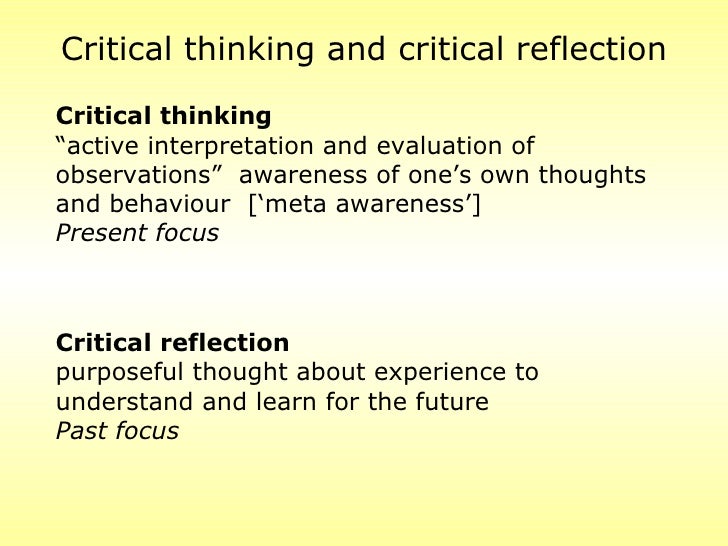3. Using reflection and critical thinking to address health and social care dilemmas and solve problems -by alexandra-iulia.popa19@bathspa.ac.uk
One of the tools in enabling one to address health and social care dilemmas and solve problems in the development of a reflective journal. The three-step- the reflective framework is the technique that can help to develop the systematic reflective practice in order to improve one’s personal and professional skillsThe first step of the framework is the description of the event. It requires one to write down what has happened, including environmental circumstances, people who were involved and their actions during the event, self-experience, actions, responses to the event and how did it make one feel. Once the description notes are recorded it is time to analyse. The second step of analysis includes many questions, why did the event happen, was is building up/expected or sudden/unexpected event, why one and others reacted in that particular way, did it lead to positive or negative outcomes and why. The purpose of the second step is to become an active and reflective learner. Once all the questions are analysed and answers are proposed, it is time to move to the final step of action. The first part of the final step in case of a negative outcome is to establish errors that occurred and what could have been done to avoid them. In contrast, if the outcome was good, it needs to be identified what has led to the successful result. The second part of step three is to plan actions for the future in case of a similar event.
The important point of the reflective journal is that it has to be done in writing on regular basis. Writing enables one to concentrate on the details, create sections, graphs or tables for better visual understanding, put emotions aside, take self away from the event and view it from the side. Moreover, it teaches to separate description from the analysis and set the time for reflection. In addition, it allows to go back to the previous section and add things if remember extra details. After completing two steps it allows one to read through them when drafting an action plan for future practice. It teaches to carefully identify and analyse by following simple steps, which in some time would become a habit of doing it on regular basis subconsciously and evolve into a critical reflective person and professional.
The other good way to address the issues in the health and social care
sector is the establishment of two-way communication through the implementation of
the feedback system for both: colleagues and clients. It is important to note
that feedback is closely linked to reflective practice as enables multiple
dimensions’ view and eliminates personal biases. It allows to take into
account the opinion and feeling of the other people of interest and assess the
impact of self-actions on the wider social network which is crucial in health
and social care practice. There are frameworks that help the feedback
implementation. One of the widely used feedback models is the DESC feedback
receiving/giving technique that contains four steps: description, effect,
solution and conclusion
The paper provided insight into reflection within the
health and social care settings, by breaking it down into three main parts of
theories and models of reflective practice, value and application of critical
thinking, and application of reflection and critical thinking in order to
tackle the problems. It introduced and explained the various tools and
frameworks that enable and encourage the learning of reflective practice.
Moreover, it evaluated the significance of developing self-reflection in a
sense of personal and professional growth.
Fook, J. (2012. 1st Edition. Critical Reflection in Context: Applications in Health and Social Care Routledge
Key web-based and electronic resources
Free Ethical Learning and Development Resource for People and Organisations
http://www.businessballs.com/reflective-practice.htm
The Foundation for Critical Thinking website for Students and Professionals
www.Criticalthinking.org
Gibbs, G., 1988. Learning by Doing: A guide to teaching and learning methods. Oxford: Oxford Brookes University.
Kolb, D. A., 1984. Experiential learning: experience as the source of learning and development. Englewood Cliffs(New Jersey): Prentice Hall. [pdf]
Available at: https://www.researchgate.net/profile/David-Kolb-2/publication/235701029_Experiential_Learning_Experience_As_The_Source_Of_Learning_And_Development/links/00b7d52aa908562f9f000000/Experiential-Learning-Experience-As-The-Source-Of-Learning-And-Development.pdf
Atkins, S. and Murphy, K. (1993) ‘Reflection: a review of the literature’, Journal of Advanced Nursing, vol. 18, pp. 1188–1192.
Cottrell, S. (2013) ‘The Study Skills Handbook’, Palgrave Study Skills Series, 4th edn, Palgrave Macmillan.
Dewey, J. (1903) Studies in Logical Theory, University of Chicago Press, Chicago.
Dewey, J. (1910) How We Think, DC Heath, Boston.
Dye, V. (2011) ‘Reflection, Reflection, Reflection: I’m thinking all the time, why do I need a theory or model of reflection?’ in McGregor, D. and Cartwright, L. (eds) Developing Reflective Practice: A Guide for Beginning Teachers, Open University Press.
Gibbs, G. (1988) Learning by Doing: A Guide to Teaching and Learning Methods, Further Education Unit, Oxford.
Mezirow, J. (1990) Fostering Critical Reflection in Adulthood: A Guide to Transformative and Emancipatory Learning, Jossey-Bass, San Francisco.
Schön, D. (1983) The Reflective Practitioner: How Professionals Think in Action, TempleSmith, London.
Syed, N., Scoular, A. and Reaney, L. (2012) ‘Faculty of public health tips on writing effective reflective notes’, Faculty of Public Health of the Royal College of Physicians of the United Kingdom [Online]. Available at: http://www.fph.org.uk/ uploads/ FPH%20Tips%20on%20Writing%20Effective%20Reflective%20Notes.pdf






No comments:
Post a Comment